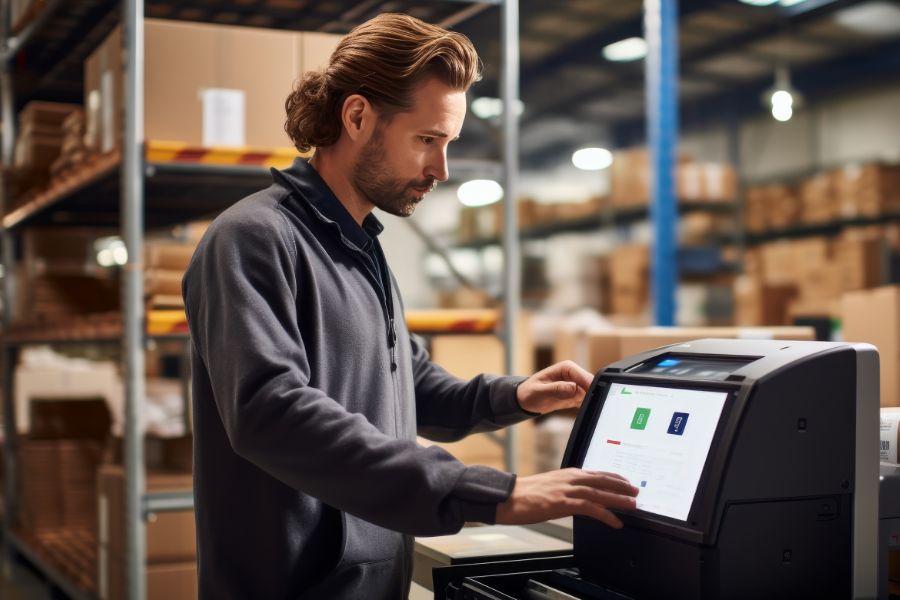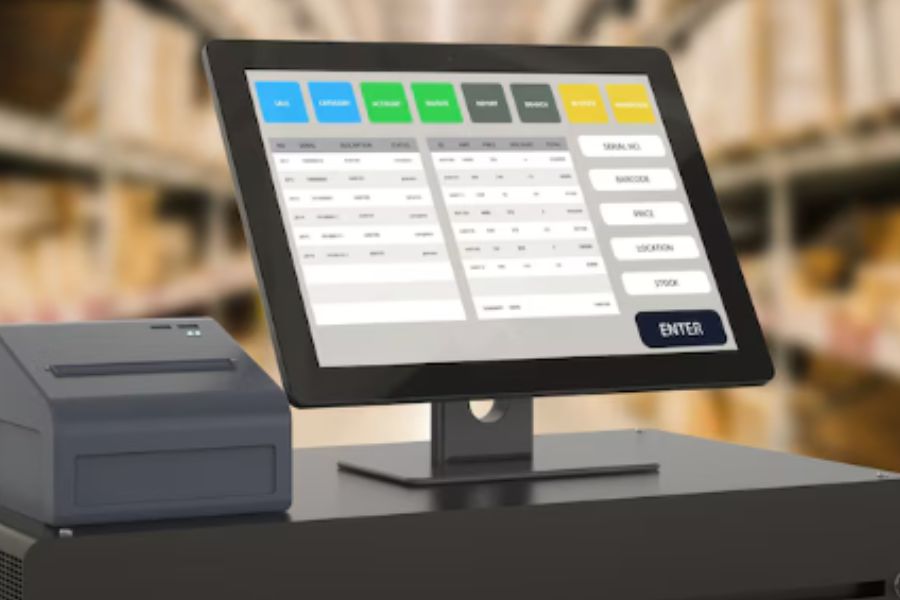“What is order fulfillment?” – before jumping into the fulfilling market, this is the first question you need to answer. It is a highly competitive market with great potential, projected to grow at a rate of 9.5% over the forecast period and worth $198.62 billion by 2030. Solid preparation is crucial in this domain where efficiency meets opportunity. Any business that wants to capitalize on this potential must understand the intricacies of order fulfillment. This article covers the basics of this process to navigate the complexities and position your business for success in the marketplace.
What Is Order Fulfillment?
Order fulfillment is the process that a company uses to ensure that customer orders are efficiently picked, packed, and dispatched. It is not just a logistical task but is actually the operational core of any e-commerce or retail business that sells physical goods.
This process includes managing inventory, handling goods storage, and delivering products to customers. Its importance cannot be overstated, as it directly affects the delivery time, accuracy, and condition in which goods arrive, all of which are crucial to customer satisfaction and business reputation.
When executed well, order fulfillment can become a significant competitive advantage. It contributes to a streamlined shopping experience that encourages repeat business and customer loyalty.
How Does Order Fulfillment Work?
The order fulfillment process consists of 7 key stages that ensure that a customer’s order is delivered accurately and on time.
1. Receiving Inventory
The process begins with inventory management, where businesses monitor stock levels to ensure they can fulfill orders as they come in. Proper inventory management minimizes the risk of stockouts and delays in the order fulfillment process.
2. Processing Orders
Once a customer places an order, the order processing stage kicks in. This includes verifying the order details, checking inventory for availability, and then moving on to the next stage.
3. Picking
This step involves workers going to the warehouse storage areas to ‘pick’ the right products for each order. It’s a critical step that requires accuracy to ensure that customers receive exactly what they ordered.
4. Packing
After picking the items, the next step is to pack them securely for shipment. This involves selecting the right type and size of packaging materials to protect the products during transit. The goal is to keep items safe while also considering shipping costs, which can be affected by the size and weight of the package.
5. Shipping
Once the order is securely packed, it’s labeled with the customer’s address and shipping details and then dispatched through a shipping carrier. Depending on the shipping options offered, this could range from standard to expedited shipping services.
6. Delivery
The shipping carrier transports the package to the customer’s delivery address. Upon delivery, the fulfillment process reaches its primary goal as the customer receives their order.
7. Returns Processing
An effective order fulfillment process also includes a hassle-free return policy. When customers return products, they need to be received back into inventory, inspected, and either restocked or disposed of, depending on their condition and the company’s return policy.
6 Key Advantages of Order Fulfillment
A well-managed order fulfillment process is critical for businesses to thrive, especially those whose operations rely on the timely delivery of physical products.
Enhanced customer satisfaction
The cornerstone of a successful business is customer satisfaction, which is heavily influenced by the fulfillment process. Timely delivery, accurate orders, and clear communication throughout the shipping process ensure that customers have a positive experience. By receiving their items promptly and as described, customers are more likely to trust and remain loyal to a brand.
Improved operational efficiency
Efficiency in order fulfillment translates to faster processing times, fewer errors, and optimized labor use. Streamlined workflows allow for quick picking, packing, and shipping, which reduces the need for corrective actions and manual intervention. This efficient use of resources not only speeds up the entire process but also maximizes the use of warehouse space, thereby cutting down on overhead costs.
Scalability of business operations
An effective fulfillment strategy provides the flexibility to manage varying order volumes without compromising on service quality. Whether it’s a seasonal surge or a steady increase due to business growth, a scalable fulfillment process allows businesses to adapt quickly and seamlessly.
Enhanced inventory management
Maintaining optimal stock levels is a delicate balance that an adept fulfillment process helps to achieve. By keeping track of inventory in real time and using predictive data for restocking, businesses can avoid the pitfalls of overstocking or running out of popular items, thus ensuring that products are always available when customers place orders.
Cost savings and financial benefits
Reducing expenses is a direct benefit of an efficient order fulfillment process. By negotiating better shipping rates, optimizing packaging, and minimizing product damages during transit, businesses can save on shipping and handling costs. Additionally, a smooth process reduces the likelihood of returns, which otherwise could erode profit margins.
Competitive edge in the marketplace
Offering faster shipping options and hassle-free returns can set a business apart, making it more attractive to customers who value these services. In a market where consumers have plenty of choices, the ability to fulfill orders quickly and reliably can be a deciding factor in winning and retaining customers, thereby fostering brand loyalty and encouraging positive word-of-mouth referrals.
4 Current Challenges of Order Fulfillment
As businesses strive to meet customer expectations and manage logistics efficiently, they encounter several challenges in the realm of order fulfillment. These challenges can impact operational efficiency and customer satisfaction.
Global supply chain disruptions
The delicate balance of global supply chains is often disrupted by unforeseen events, such as political unrest, health crises, and environmental disasters. These disruptions can lead to critical delays and shortages, directly impeding the fulfillment process.
For instance, ongoing Houthi attacks have resulted in Red Sea diversions, further straining the supply chain by increasing costs and tying up capacity (updated February 2024, Frieghtos).
Rising shipping costs
As of February 2024, transportation costs have surged, particularly in maritime shipping. Ocean rates have spiked, particularly across ex-Asia lanes, due to geopolitical tensions. Carriers are imposing higher rates and surcharges, with some aiming to exceed the $6,000 mark per forty-foot equivalent unit (FEU).
Additionally, backhaul rates have seen a doubling since mid-December. In the context of Asia to North America West Coast shipping, rates are anticipated to hit the $5,000 per FEU threshold mid-month. Transatlantic routes are experiencing similar inflation, with carriers announcing General Rate Increases (GRIs) that could reach $5,000 per FEU. This complex market environment suggests imminent capacity shortages and congestion, with relief only expected as demand declines later in the year.
Elevated customer expectations
Modern consumers have high expectations for fast, free, or low-cost delivery, easy returns, and real-time order tracking. Meeting these expectations requires sophisticated logistics and can be particularly challenging for smaller businesses that may not have the infrastructure or partnerships to offer such services at scale.
Labor shortages and workforce management
The fulfillment industry is heavily dependent on manual labor, especially in the picking and packing stages. However, many regions are experiencing workforce shortages, which hinder the ability to scale up during high-demand periods. Balancing the fluctuating needs of the workforce, especially in peak seasons, requires strategic human resources planning and can lead to increased operational costs.
5 New Trends in Order Fulfillment in 2024
The landscape of order fulfillment is continuously evolving, adapting to the latest technologies and market demands.
- Cross-border logistics
International expansion is becoming increasingly accessible for businesses of all sizes. Smaller companies are finding it viable to enter larger markets and engage in cross-border sales.
This globalization of commerce is facilitated by user-friendly e-commerce platforms such as Shopify or WooCommerce and the proliferation of globally operating fulfillment centers. These centers, with their expansive logistics networks, enable smooth and straightforward international trade.
- eFulfillment
The digital transformation has made its mark on the fulfillment industry with the introduction of advanced logistics management tools.
These tools, such as sophisticated eFulfillment solutions, streamline logistics processes through software-based systems that can effortlessly scale to accommodate seasonal fluctuations and large-scale marketing campaigns. This scalability ensures businesses remain competitive, allowing them to focus on their primary operations while maintaining constant oversight of their logistics, accessible from computers and smartphones anywhere, eliminating the need for endless order confirmations and reducing paperwork.
- Real-time tracking
While it has become the norm in many sectors, some e-commerce merchants still do not offer parcel tracking due to a lack of technical integration or limitations from their logistics providers.
However, there is a growing expectation among fulfillment customers for transparent, real-time visibility into warehouse operations to stay informed at every stage.
- Sustainability
Despite being momentarily overshadowed by other global crises in 2023, climate change remains a critical issue.
Governments, cities, and corporations have pledged to reduce greenhouse gas emissions, and this commitment extends into the world of fulfillment. Consumer demand for sustainable practices is on the rise, with preferences for eco-friendly alternatives like plastic-free packaging, recycled materials, and carbon-neutral shipping options. Fulfillment strategies now have to align with these environmental responsibilities, which represent not just a trend but an imperative.
- Leveraging big data and analytics
The strategic application of big data and analytics is revolutionizing the way companies approach logistics.
By analyzing historical data, businesses can predict trends, adjust inventory levels in anticipation of consumer demand, and optimize delivery routes. The insights gleaned from big data not only drive efficiency and cost savings but can also contribute to environmental sustainability by reducing the carbon footprint of logistics operations.
Which Fulfillment Method Is Suitable for My Business?
Deciding on the most appropriate fulfillment method for your business can be a complex decision, influenced by various factors, including operational scale, control preferences, cost constraints, and growth ambitions.
Here’s an analysis of three widely utilized fulfillment strategies: dropshipping, self-fulfillment, and fulfillment services, to help determine which might be the best fit for your business.
Dropshipping
Dropshipping is a lean fulfillment model where you sell products that are shipped directly from the supplier to the customer.
This method eliminates the need for you to manage inventory, warehousing, and shipping logistics, making it a low-risk option with minimal upfront investment. It allows businesses to offer a wide array of products without the need for large storage spaces or significant capital to purchase inventory.
However, it also means relinquishing control over shipping times and inventory management, potentially leading to longer delivery times and less opportunity for branding. Profit margins can be lower, since the cost price from suppliers includes their fulfillment services.
Dropshipping is suitable for new entrepreneurs and small businesses that want to minimize risk and test the market without committing substantial resources.
Self-Fulfillment
Self-fulfillment, also known as in-house fulfillment, involves managing the entire process from storing inventory to packing and shipping orders yourself.
This method gives you full control over the fulfillment process, allowing you to personalize the customer experience with branded packaging and include personal touches.
While it can be cost-effective for businesses with a small number of orders, it requires significant time and effort to manage. As the business grows, the challenges of scaling up—such as finding additional storage space and handling more complex logistics—can become significant.
Self-fulfillment is often the method of choice for startups and small businesses that have the capacity to manage fulfillment processes and wish to maintain close control over every aspect of the customer experience.
Fulfillment Services
Using fulfillment services involves outsourcing your logistics to a third-party provider.
These services can handle high volumes of orders, manage inventory across multiple channels, and often offer faster shipping times due to their established logistics networks. They can also handle returns and exchanges, which can be particularly beneficial for businesses with high sales volumes.
Nevertheless, this convenience comes at a cost, and you’ll have less direct control over the fulfillment process. Fulfillment services also require you to trust your provider to maintain the quality of service your customers expect.
This option is best for businesses that are scaling quickly and need the capacity to handle a high volume of orders without the added stress of managing logistics in-house.
Essentials for Effective Order Fulfillment
To ensure a seamless order fulfillment operation, businesses must set up a comprehensive system adept at managing stock levels, processing transactions, and punctually delivering orders to customers.
Below are the key elements necessary for a smooth and efficient order fulfillment workflow.
Point of Sale (POS) system
A Point of Sale (POS) system like ConnectPOS plays a pivotal role in modern order fulfillment. It acts as the hub where sales are processed, and it can also keep track of inventory levels in real time.
ConnectPOS offers seamless integration between in-store and online sales, ensuring that inventory is accurately accounted for across all channels. This system helps in preventing overselling and stockouts, and it can also facilitate click-and-collect services where customers buy online and pick up in-store, blending the online and offline experience for both the retailer and the consumer.
Inventory management
Effective order fulfillment is contingent on robust inventory management. Accurate inventory tracking ensures that you can meet customer demand without the risk of overselling or stockpiling too much product.
Inventory management systems help in forecasting demand, setting reorder points, and managing suppliers. They can also provide insights into bestsellers and slow-moving items, which can inform purchasing decisions and help optimize stock levels.
Warehouse management
For businesses that maintain their own inventory, warehouse management is crucial. A well-organized warehouse allows for faster picking and packing, reducing the time from order to dispatch.
Warehouse management systems (WMS) can optimize the layout of your warehouse and manage the picking process to improve efficiency and accuracy in order fulfillment.
Packing supplies and shipping solutions
Having the right packing materials ensures that products are secure during transit and arrive in good condition. For businesses looking to enhance the customer experience, this might include boxes, bubble wrap, packing peanuts, tape, and branded packaging.
Additionally, businesses need reliable shipping solutions to transport products to the customer. This could involve contracts with courier services, access to tracking information for customers, and the ability to handle returns efficiently.
Takeaways
Now you have the answer to “What is order fulfillment?”. The art of order fulfillment encompasses a variety of components, all of which are crucial for maintaining the pulse of a thriving business. From choosing the right fulfillment method—be it dropshipping, self-fulfillment, or third-party services—to implementing a robust infrastructure for inventory and warehouse management, businesses must navigate these elements skillfully. Embracing technologies such as real-time tracking and analytics will further refine the fulfillment process, meeting the modern consumer’s expectation for speed, transparency, and sustainability.
For businesses looking to harness the power of ConnectPOS to elevate their fulfillment strategy, feel free to contact us!
FAQ: What Is Order Fulfillment
1. What are the key benefits of integrating a POS system like ConnectPOS with my order fulfillment process?
Integrating ConnectPOS with your order fulfillment process offers numerous benefits, including real-time inventory tracking, unified sales channels, and streamlined transactions. This integration ensures that stock levels are updated instantly across all platforms, reducing the risk of overselling and enabling a smoother customer experience from purchase to delivery.
2. How does a business determine the most suitable order fulfillment method?
To determine the most suitable order fulfillment method, a business should evaluate its size, product types, order volume, and growth projections. Consider factors such as the desired level of control over inventory, capital investment, and the scalability of the fulfillment process. Analyzing these aspects will help identify whether dropshipping, self-fulfillment, or using fulfillment services aligns best with the business’s operational needs and long-term goals.
3. Can ConnectPOS accommodate both online and offline sales for a seamless customer experience?
Yes, ConnectPOS is designed to handle both online and offline sales, providing a cohesive experience for customers. It facilitates omnichannel retail by allowing businesses to offer services such as click-and-collect, ensuring inventory is consistent across all sales channels, and enabling customers to shop flexibly according to their preferences.



